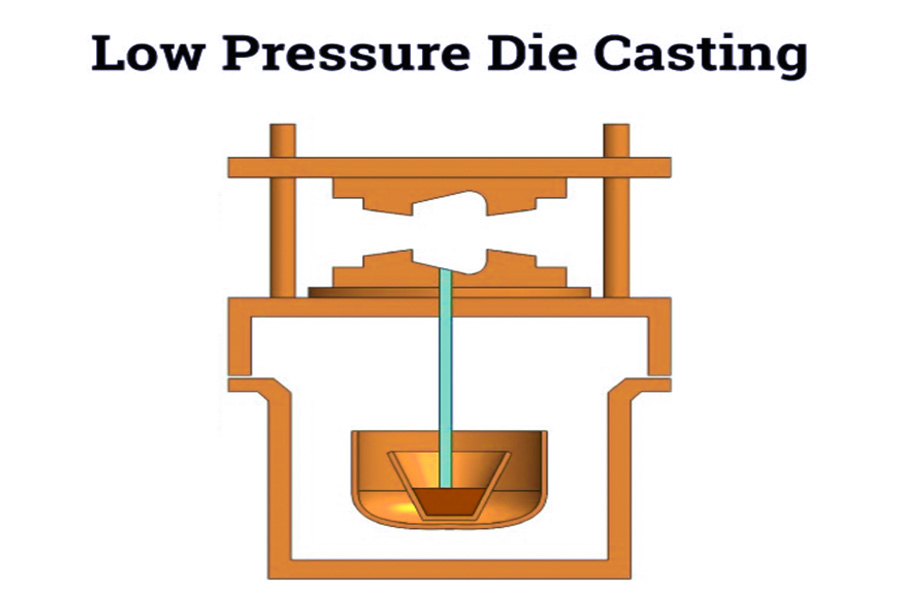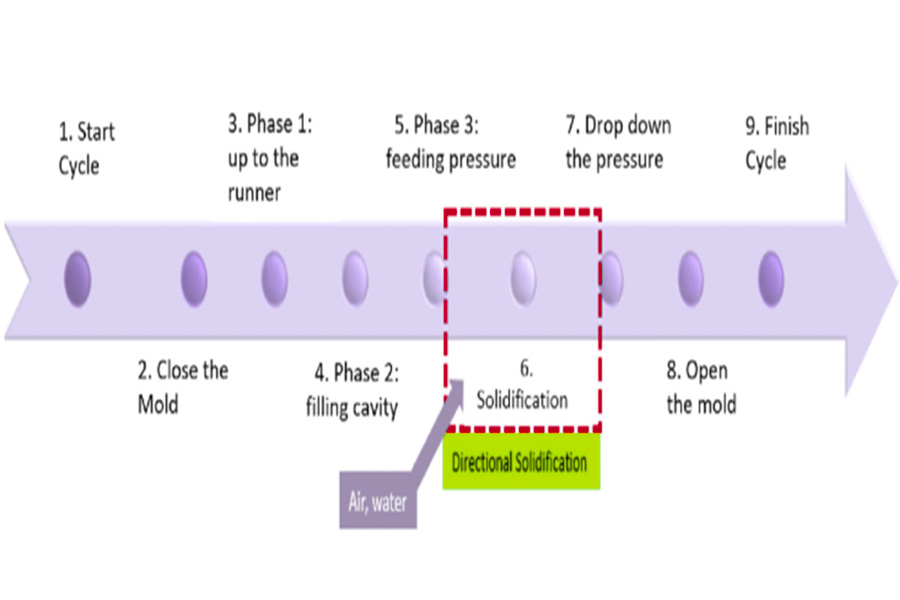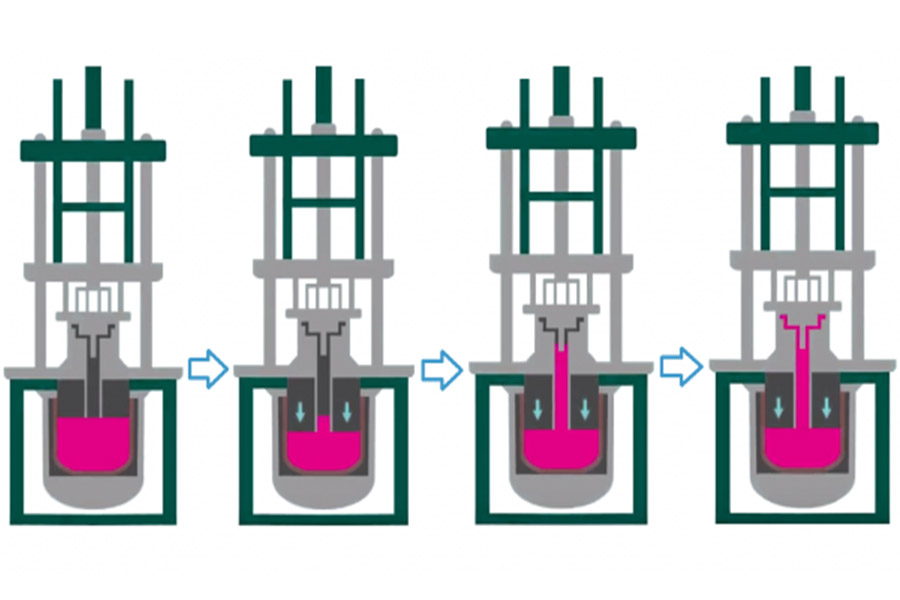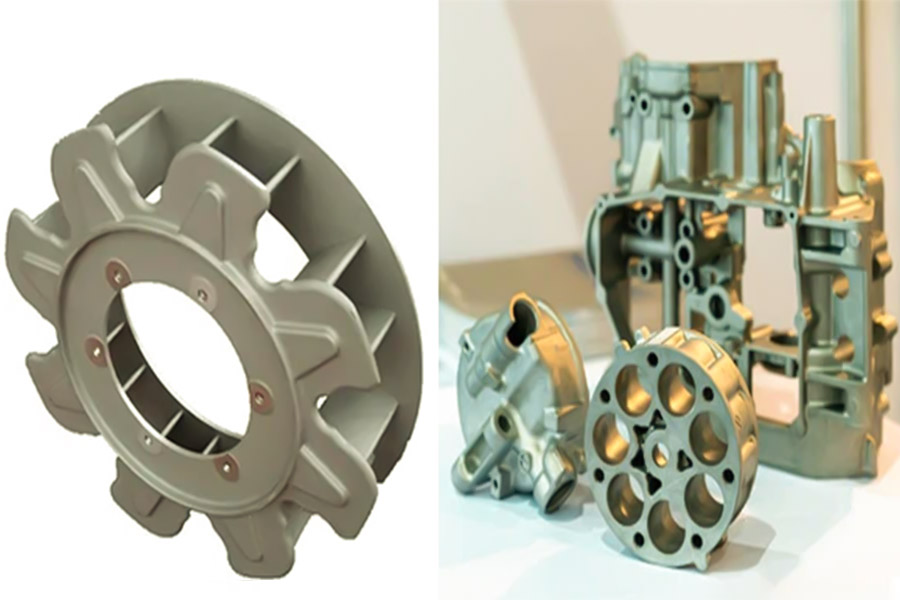Low pressure casting is a unique casting processthat presses liquid alloy into the mold cavity from bottom to top under pressure and solidifies under pressure to obtain castings. This casting method not only improves the purity and quality of castings, but also has the advantages of high production efficiency and easy automation. This article will introduce the working principle, process flow andcharacteristics of low pressure castingin detail.
What is Low Pressure Casting?
Low pressure casting is a metal forming processthat uses gas pressure as a driving force to push molten metal to fill the mold cavity smoothly and evenly, and complete the solidification process under controlled environmental conditions. This technology is usually carried out in a sealed casting system. By precisely regulating the size and time of gas pressure, it can achieve fine control of the filling speed and solidification process of molten metal.
Low pressure casting can not only effectively avoid defects such as turbulence, oxidation and pores caused by molten metal during mold filling, but also improve the density, mechanical properties and surface quality of castings. Therefore,it is widely used in aerospace, automobile manufacturing, power equipment and precision instruments. It has a wide range of applications in high-end manufacturing fields.

How Does Low Pressure Casting Work?
The basicprinciple of low pressure castingis to use dry compressed air or inert gas introduced into the sealed crucible to exert a certain pressure on the molten metal surface, so that the molten metal will be smoothly filled with the mold from bottom to top along the riser tube. The whole process can be divided into the following stages:
1.Metal melting and preparation of molds or molds:First, the metal raw material is smelted into a liquid state and the desired mold or mold is prepared.
2.Preparation before pouring: Including the sealing of the crucible (assembling the sealing cover), the slag scraping in the riser pipe (removing impurities), measuring the liquid level height, carrying out the tightness test, mold matching, and fastening the mold or mold, etc.
3.Pouring:
- Liters of liquid: The molten metal rises along the riser tube under the action of gas pressure.
- Filling: The molten metal smoothly passes through the sprue into the mold cavity.
- Supercharge: Maintain the gas pressure on the liquid metal surface until the casting is completely solidified.
- Congeal: The molten metal crystallizes and solidifies under pressure.
- Relieve pressure: Relieves the gas pressure on the liquid surface so that the molten metal that has not solidified in the riser pipe and sprue flows back to the crucible.
- Cooling: The casting is cooled to room temperature in the mold.
4.Release: Includes loose demoulding and removal of castings.

What Are the Steps in the Low Pressure Casting Process?
Theprocess flow of low pressure castingmainly includes the following steps:
-
Metal smelting: The metal raw material is put into the crucible for smelting, and the temperature and composition of the molten metal meet the process requirements.
-
Mold preparationAccording to the design requirements of the casting, the required mold is prepared and pre-heated, so as to prevent the molten metal from cooling too quickly during the filling process.
-
Preparation for pouring: Seal the crucible, remove impurities from the riser tube, ensure the tightness of the system, and carry out the necessary inspections and adjustments.
-
Pouring process:
- Liters and fillingUnder the action of gas pressure, the molten metal rises along the riser tube and smoothly fills the mold cavity.
- Pressurization and coagulation: Maintain the gas pressure on the liquid metal surface to make the casting crystallize and solidify under pressure.
-
Depressurization and cooling: Relieves the gas pressure on the molten metal surface, allows the unsolidified molten metal to flow back to the crucible, and then allows the casting to cool naturally in the mold.
-
Demoulding and removal of castingsAfter the casting is completely cooled, open the mold and take out the casting.

What are the advantages and disadvantages of low pressure casting?
As a unique casting process,low pressure casting has a series of significant advantagesand certain limitations. The following is a detailed analysis of theadvantages and disadvantages of low pressure casting:
Advantages
1. High quality castings:
- Pure molten metal filling:The slag generally floats on the surface of the molten metal, while the low-pressure casting is filled through the riser tube, which avoids the slag from entering the mold cavity and improves the purity of the casting.
- Good formability:the molten metal is filled under pressure, and the fluidity is enhanced, which is conducive to the formation of castings with clear contours and smooth surfaces, especially suitable for the forming of large thin-walled castings.
- Dense structure:The casting crystallizes and solidifies under pressure, which can be fully replenished, with dense structure and high mechanical properties.
2. High yield of molten metal:
In general, there is no need for a riser, and the unsolidified molten metal in the riser tube can be refluxed to the crucible for reuse, so that the yield of the molten metal is greatly improved, usually up to more than 90%.
3. High production efficiency and degree of automation:
The working conditions are good, the equipment is simple, it is easy to realize mechanized and automated production, and the production efficiency is improved.
4. Wide range of application:
Low pressure casting can be used to cast a variety of alloys, including non-ferrous alloys, cast iron, and cast steel, among others. It is especially suitable for non-ferrous alloys that are easy to oxidize, and can effectively prevent the oxidation of slag inclusions in the pouring process of molten metal.
5. Low requirements for mold materials:
All kinds of materials that can be used as casting molds, such as sand molds (clay sand, sodium silicate sand, resin sand, etc.), shell molds, metal molds, graphite molds, investment precision casting shell molds, ceramic molds, etc., can be used ascasting materials for low pressure casting.
Disadvantages
1.Large investment in equipment:
Thelow pressure casting equipmentincludes the main engine, hydraulic system, holding furnace, liquid level pressurization device, electrical control system and casting cooling system, etc., and the overall investment is large.
2.The production efficiency is relatively low:
Compared with gravity die casting andhigh pressure casting, low pressure casting has lower production efficiency and longer casting cycle. In order to maintain directional solidification and fluidity of the melt, the mold temperature is high and the solidification speed is slow.
3.The management requirements are strict:
The structure close to the gate is coarse, and the mechanical properties of the lower profile are not high, which requires comprehensive and strict management, including the control of process parameters such as temperature and pressure.
4.Riser tubes have a limited lifespan:
In the process of long-term contact with molten metal, riser tubes are susceptible to erosion and scrap and need to be replaced regularly.
What Metals are Commonly Used in Low Pressure Casting?
1. Casting material
Casting material is the substance used to make casting patterns, andlow pressure casting can use a variety of casting materialsto adapt to the needs of different castings. Common mould materials include:
- Molding sand:a commonly used casting material with good formability and air permeability, suitable for making castings with complex shapes.
- Resin sand:a mixture of resin and sand particles, with high strength and hardness, suitable for making high-precision and high-quality castings.
- Metal:such as copper, iron, aluminum and other metal materials, can be used to make metal mold castings, with high thermal conductivity and good wear resistance.
- Ceramics:With high hardness and high temperature resistance, it is suitable for manufacturing high temperature alloy castings.
- Graphite:With good self-lubrication and high temperature resistance, it is suitable for manufacturing castings that require self-lubrication or high temperature resistance.
- Gypsum:Easy to shape and demold, suitable for manufacturing small and complex shaped castings.
2. Mold materials
Mold material is the material used to make low pressure casting mold. Low pressure casting mold needs to withstand the erosion and pressure of high-temperature metal liquid, so the selection of mold material is very important. Common mold materials include:
- Cast iron:low cost, easy to process, but easy to deformation, relatively short life. Suitable for manufacturing castings with low mold life requirements.
- Alloy steel:with high hardness and strength, good wear resistance, suitable for the manufacture of high precision and high quality casting mold.
- Carented carbide:with high hardness and high wear resistance, suitable for manufacturing molds requiring high scouring force and high pressure.
- Tungsten handle:with extremely high hardness and wear resistance, but the cost is high, suitable for the manufacture of mold life and wear resistance requirements.
- Aluminum alloy:small density, high strength, good rigidity, good thermal conductivity, light quality, easy to machining and welding, can be suitable for the manufacture of large and medium-sized molds.

What are the Typical Applications of Low Pressure Casting?
Typical applications of low pressure castingcover a variety of fields such as automobiles, aerospace and consumer products. The following is a detailed summary of these applications:
1.Automobile manufacturing:
In the automotive industry,low pressure casting is widely used to produce key parts such as wheels, engine parts (such as cylinder blocks, cylinder heads), suspension parts, etc. These parts require high strength, high precision and good corrosion resistance. Low-pressure casting technology can meet these requirements and improve the reliability and durability of automobiles.
2.Aerospace:
In the field of aerospace,low pressure casting is used to manufacture lightweight structural parts such as aircraft engine blades, turbine parts, etc. These parts need to withstand the harsh environment of high temperature, high pressure and high speed operation. Low pressure casting technology can provide materials with high strength, high toughness and heat resistance to ensure the safety and performance of aerospace vehicles.
3.Consumer goods manufacturing:
In the consumer goods field,low pressure casting is used to produce high quality electricaland electronic product housings, kitchenware, furniture accessories, etc. These products require exquisite appearance and good durability. Low pressure casting technology can provide high precision, high-gloss and corrosion-resistant materials to meet consumers' demand for product quality.
4.Other industrial fields:
Low pressure casting is also used in other industrial fields, such as shipbuilding, heavy machinery manufacturing, etc. In these fields, low pressure casting technology can produce large, complex shapes and high-performance castings to meet the requirements of industrial equipment for high strength, high precision and long life.
Choose LS as your trustworthy partner
LS Steel is certainly one of China’s high aluminumand zinc die casting manufacturing service suppliers. Along with casting, we additionally present prototyping, tooling, machining, and floor ending providers. We use essentially the most superior expertise for die-casting manufacturing. OurCNC machining serviceruns with one of the best expertise and a decade-long skilled engineers and employees. We provide one of the best cost-saving and technical machining design and manufacturing solutions you may ask for. Here’s a record of our CNC machining capabilities:
- Our CNC milling store incorporates5-axis CNC machinesthat are extremely exact. These machines are able to offering tolerance as much as 0.005mm.
- We now have speedy CNC fixture expertise that ensures quicker machining and on-time supply for our purchasers.
- Our machining service is just not just for casting parts but additionally for a lot of sorts of plastics and chrome steel parts.
- From superior CNC lathes and EDM machines to floor grinders and wire slicing machines, we’ve got every little thing you want for machining in our machine store.
The machined casting process is just not the ultimate job for a casting half. Floor ending can also be an vital a part of casting manufacturing. Holding that in thoughts, we offer surface finishing providers like anodizing, powder coating, chrome plating, moist portray, and many others. So you may see thatLS Steel suppliesthe whole resolution to die casting manufacturing. We offer providers in China and likewise internationally. Contact us to have one of the best die casting manufacturing service from China.
FAQs
1. What is the basic process of low pressure casting?
The basic process of low pressure casting includes metal melting and preparation of molds or molds, preparation before pouring (such as crucible sealing, slag removal of riser pipes, measurement of liquid level height, etc.), pouring (including stages of liquid lifting, molding, pressurization, solidification, pressure relief and cooling), and demoulding (including loose demoulding and removal of castings).
2. What are the main components of low-pressure casting equipment?
Low-pressure casting equipment is generally composed of the main engine, hydraulic system, holding furnace, liquid level pressurization device, electrical control system and casting cooling system. Among them, there are two main types of holding furnaces: crucible type holding furnace and molten pool holding furnace, and there are different types of crucible holding furnaces, such as cast iron pots, cast steel pots, and composite pots.
3. In which fields does low-pressure casting have typical applications?
Low-pressure casting is widely used in automotive manufacturing, aerospace, consumer goods manufacturing, and other industrial sectors. For example, in the automotive industry, low-pressure casting is used to produce key components such as wheels and engine components; In the aerospace sector, it is used in the manufacture of lightweight structural components; In the manufacture of consumer goods, it is used to produce high-quality enclosures for electrical and electronic products, etc.
4. What are the potential challenges or limitations of low-pressure casting?
Despite the many advantages of low-pressure casting, there are some potential challenges or limitations. For example, the equipment cost and mold investment are large; In the production of aluminum alloy castings, crucibles and riser tubes are in contact with molten metal for a long time, which is susceptible to erosion and scrapping; In addition, production efficiency is relatively low, especially when dealing with large or complex-shaped castings.
Summary
As an efficient and high-quality casting method,low pressure casting plays an irreplaceable rolein the field of industrial manufacturing. Through continuous optimization of technology and equipment, we have reason to believe that low pressure casting will continue to lead the development trend of metal forming technology in the future and inject new vitality into industrial manufacturing.
Disclaimer
The content on this page is for reference only.LSdoes not make any express or implied representation or warranty as to the accuracy, completeness or validity of the information. No performance parameters, geometric tolerances, specific design features, material quality and type or workmanship should be inferred as to what a third party supplier or manufacturer will deliver through the Longsheng Network. It is the responsibility of the buyerseeking a quote for partsto determine the specific requirements for those parts.Pleasecontact usfor moreinformation.
LS Team
LS is an industry-leading companyspecializing in custom manufacturing solutions. With over 20 years of experience serving more than 5,000 clients, we focus on high-precisionCNC machining,sheet metal fabrication,3D printing,injection molding,metal stamping,and other one-stop manufacturing services.
Our factory is equipped with more than 100 advanced 5-axis machining centers and is ISO 9001:2015 certified. We provide fast, efficient, and high-quality manufacturing solutions to customers in over 150 countries worldwide. Whether it’s low-volume production or large-scale customization, we can meet your needs with delivery as fast as 24 hours. ChoosingLS Technologymeans choosing efficiency, quality, and professionalism.
To learn more, please visit our website:www.lsrpf.com







